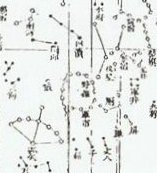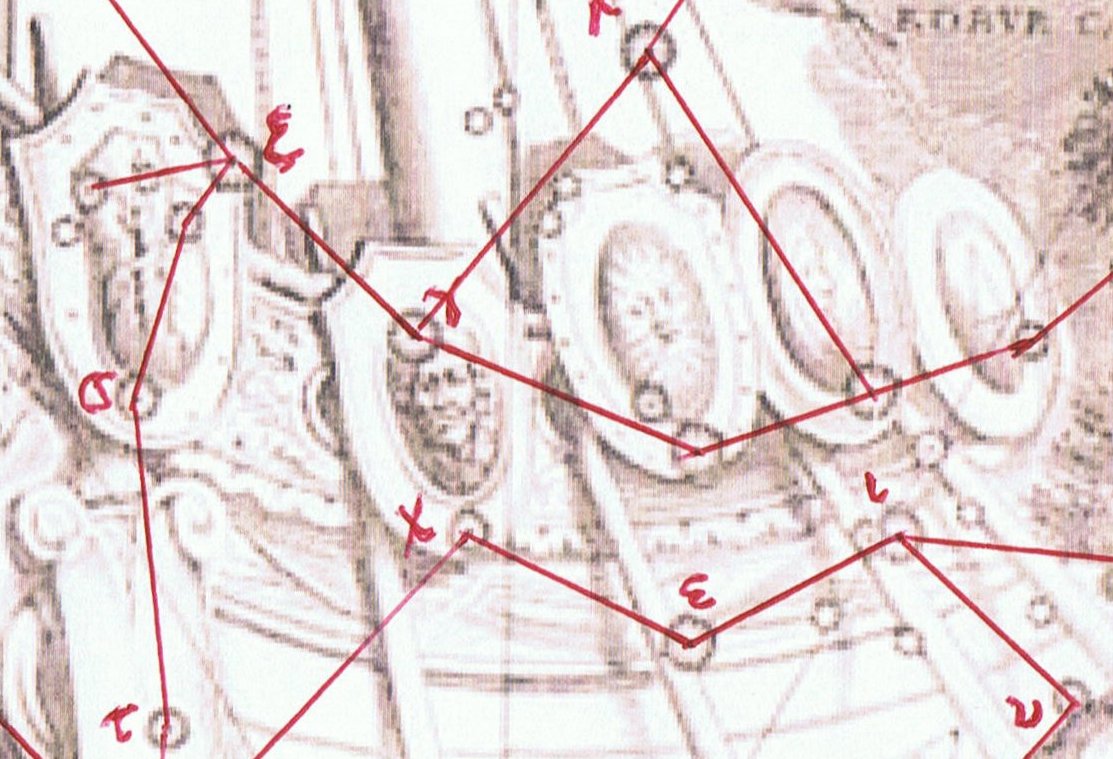Next new Columba stars are λ (Tze), ξ, and σ: "In China they [the stars in our Columba] were Sun, the Child; λ being Tsze, a Son; and the nearby small stars, She, the Secretions." (Allen)
Etamin in the night of Gregorian day 168 is one of the names for the southernmost star (γ) in Draco, and a name which I once fetched from Wikipedia.
"Eltanin, also written Ettanin, Etannin, Etanim, Etamin, etc., is from Ulug Beg's Al Rās al Tinnīn, the Dragon's Head, applied to this, as it also is to α; Riccioli wrote it Ras Eltamin. The word Tinnīn is nearly synonymous with Thu'bān, and Bayer, mentioned Rastaben as one of its titles, the Alfonsine Rasaben, and now Rastaban in the Century Cyclopedia: but in early Arabic astronomy it was one of the Herd of Camels ..." (Allen)
"In its unattested Proto-Canaanite form, the letter [gimel] may have been named after a weapon that was either a staff sling or a throwing stick, ultimately deriving from a Proto-Sinaitic glyph ... Bertrand Russell posits that the letter's form is a conventionalized image of a camel. The letter may be the shape of the walking animal's head, neck, and forelegs. Barry B. Powell, a specialist in the history of writing, states 'It is hard to imagine how gimel = 'camel' can be derived from the picture of a camel ..." (Wikipedia) "The word gimel is related to gemul, which means 'justified repayment', or the giving of reward and punishment." (Wikipedia). The Swedish word for 'old' is gammal. And the idea of a herd of camels immediately leads our minds into the dry desert. I think the idea of a recycled (dry old) 'stick' ('thrown back') is a reasonable explanation for the origin of gimel. But there should be a pair of them ('twins'). Hercules was a twin: ... The old man gave the Raven two small sticks, like gambling sticks, one black, one multicoloured. He gave him instructions to bite them apart in a certain way and told him to spit the pieces at one another on the surface of the sea. The Raven climbed back up the pole, where he promptly did things backwards, just to see if something interesting would occur, and the pieces bounced apart. It may well be some bits were lost. But when he gathered what he could and tried again - and this time followed the instructions he had been given - the pieces stuck and rumpled and grew to become the mainland and Haida Gwaii ... ... The navel of the ocean was a vast whirlpool in which sticks for making fire by friction were drifting about. At that time men were still without fire. Now the maiden seized her bow, shot into the navel of the ocean, and the material for fire-rubbing sprang ashore ... There was an old Chinese constellation which obviously depicted a drawn bow with arrow, and its position was beyond and below Orion, seemingly down in the Milky Way at Argo Navis - the sunken ship which has lost its Bow:
I have copied, from Hamlet's Mill, a part of the Mercator projection of 'the celestial globe of Hsin I Hsiang Fa Yao of 1092'. "δ [in Vela], 2.2, and ω [Simiram in Carina], with stars in Canis Major, were the Chinese Koo She, the Bow and Arrow." (Allen)
Simiram (ω) at bottom right and at the other side of the Royal Oak into which the Bow of the ship has disappeared, could be the point to where the hand of the invisible archer has drawn the string. I have not clarified the position of δ Velorum, but it is the star at the bottom corner below λ (Alsuhail). Between δ and λ - where maybe the feathers of the arrow might be - is the central 1 of 5 shields, with the face of the Sun (and with the face of the Moon in the next shield):
Could the Polynesians have seen this vision of Hevelius? The Polynesian word Ra means not only sun, day, etc., but also sail. |





.jpg)
